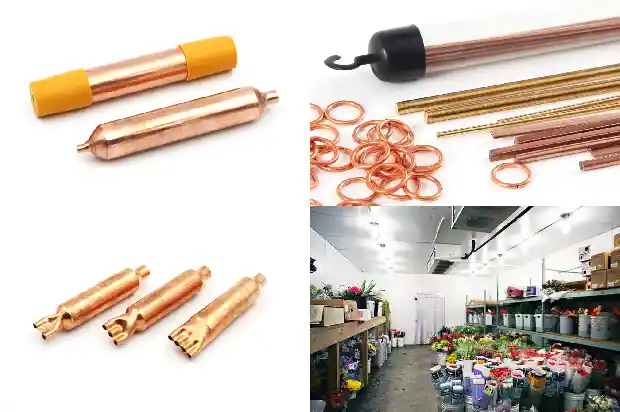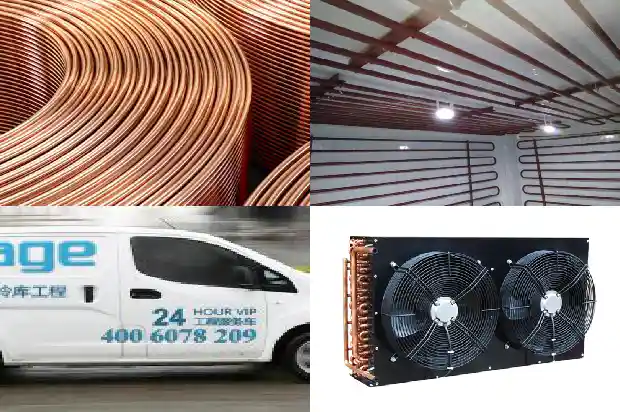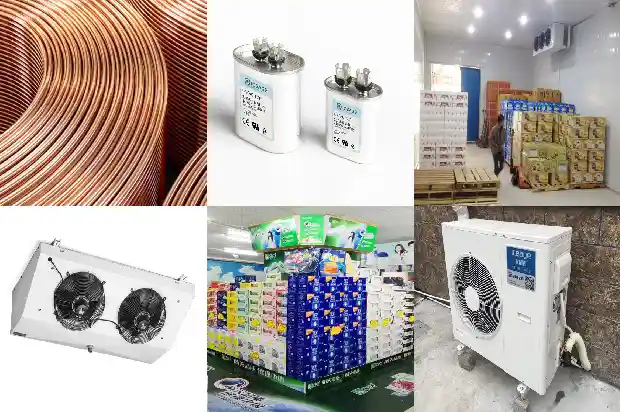Comparison of Performance of Three Common Refrigeration Compressors (Reciprocating, Screw, Centrifugal)
2024-09-29
- Screw compressor
The screw compressor is also known as the screw compressor. In the 1950s, oil-injected screw compressors were applied in refrigeration devices. Due to their simple structure, few wearing parts, and the ability to operate under large pressure differences or pressure ratios with low exhaust temperatures and being insensitive to a large amount of lubricating oil in refrigerants (often called wet strokes), they have good gas delivery adjustability. They quickly occupied the application range of large-capacity reciprocating compressors and continuously extended to the medium-capacity range. They are widely used in refrigeration devices such as freezing, refrigeration, air conditioning, and chemical process.
Screw heat pumps with it as the main unit have been used in heating and air conditioning since the early 1970s, including air source type, water heat pump type, heat recovery type, and ice storage type. In industry, screw heat pumps are also used for heat recovery to save energy. - Centrifugal compressor
The centrifugal compressor is a blade rotary compressor (i.e., turbine compressor). In the centrifugal compressor, the centrifugal force exerted on the gas by the high-speed rotating impeller and the diffusion effect on the gas in the diffusion channel increase the gas pressure.
In the early days, because this compressor was only suitable for low and medium pressure and large flow rate occasions, it did not attract people's attention. Due to the development of the chemical industry and the establishment of various large chemical plants and oil refineries, centrifugal compressors have become the key machines for compressing and transporting various gases in chemical production and occupy an extremely important position. With the achievements in gas dynamics research, the efficiency of centrifugal compressors is continuously improved. Moreover, due to the successful development of key technologies such as high-pressure sealing, processing of small-flow narrow impellers, and multi-oil wedge bearings, a series of problems in the development of centrifugal compressors towards high pressure and wide flow range have been solved, greatly expanding the application range of centrifugal compressors. As a result, they can replace reciprocating compressors in many occasions and greatly expand the application range. - Reciprocating piston compressor
It is the earliest developed type among various compressors. The wooden bellows invented in China in 1500 BC is the prototype of the reciprocating piston compressor. At the end of the 18th century, the first industrial reciprocating piston air compressor was made in the United Kingdom. In the 1930s, labyrinth compressors began to appear, followed by various oil-free lubrication compressors and diaphragm compressors. The opposed-type structure that appeared in the 1950s greatly reduced the size of large reciprocating piston compressors and realized multi-purpose use of a single machine.
Piston compressors have a long history of use and are currently the most widely used compressors in China. Due to their wide pressure range, they can adapt to a wide energy range and have advantages such as high speed, multiple cylinders, adjustable energy, high thermal efficiency, and suitability for various working conditions. Their disadvantages are complex structure, many wearing parts, short maintenance cycle, sensitivity to wet strokes, pulsed vibration, and poor running stability.
The screw compressor is a new compression device. Compared with the reciprocating type:
Advantages:
①The machine has a compact structure, small volume, less floor space, and light weight.
②High thermal efficiency, few processed parts. The total number of parts of the compressor is only 1/10 of that of the piston type. The machine has few wearing parts, safe and reliable operation, and simple operation and maintenance.
③There is no pulsation in the gas, stable operation. The unit does not require a special foundation as it is not demanding on the foundation.④During operation, oil is injected into the rotor cavity, so the exhaust temperature is low.
⑤Not sensitive to wet strokes. When wet steam or a small amount of liquid enters the machine, there is no risk of liquid hammer.
⑥Can operate at a higher pressure ratio.
⑦The effective compression stroke can be changed by means of a slide valve, and stepless cooling capacity adjustment of 10-100% can be performed.
Disadvantages:
Complex oil treatment equipment is required, including oil separators and oil coolers with good separation effects. The noise is relatively large, generally above 85 decibels, and sound insulation measures are required.
Compared with the piston type, the centrifugal type has a higher rotational speed, large gas volume, small mechanical wear, few wearing parts, simple maintenance, long continuous working time, small vibration, stable operation, low requirements on the foundation. When the gas volume is large, the unit power unit has light weight, small volume, and less floor space. The gas volume can be adjusted steplessly within the range of 30%-100%. It is easy to perform multistage compression and throttling and can meet the requirements of some chemical processes. It is easy to achieve automation. For large machines, an industrial steam turbine with higher economic efficiency can be directly driven, which has economic advantages for enterprises with waste heat steam. The disadvantages are: higher noise frequency, large consumption of cooling water, and surge may occur if operated improperly.
Three common compression refrigerators (reciprocating, screw, centrifugal)
Comparison of performance characteristics
In refrigeration systems, due to the different working principles of reciprocating refrigeration compressors and screw refrigeration compressors, the reasons affecting their pressure loss and leakage loss are also different.
For reciprocating refrigeration compressors, the main reasons affecting their pressure loss and leakage loss are the quality of the gas valves and the sealing performance when the gas valves are closed. This is because when the suction valve is opened, it needs to overcome the spring resistance (compress the spring), and when the gas flows through the gas valve, due to the smaller cross-sectional area and higher flow velocity, a certain flow resistance is generated. Therefore, during the suction process of the reciprocating refrigeration compressor, the gas pressure in the cylinder is always lower than the gas pressure in the suction pipe. Similarly, during the exhaust process of the reciprocating refrigeration compressor, the gas pressure in the cylinder is always higher than the gas pressure in the suction pipe. If the cross-sectional area of the gas valve channel is smaller, the resistance loss will be greater. If the weight of the valve plate is large and the spring force of the gas valve is also large, the resistance loss will increase, and thus the pressure coefficient value will decrease.
For screw refrigeration compressors, the main reason affecting their pressure loss and leakage loss is the gas flow velocity.
In screw refrigeration compressors, the performance of the screw is crucial.
If the tooth profile of the screw is a symmetrical arc shape, then its manufacturing is simple. If the tooth profile of the screw is an asymmetric line shape, then it has a large gas delivery screw volume and high efficiency. If the length-to-diameter ratio of the screw is reduced, the screw can have good strength, increase the reliability of the operation of the screw refrigeration compressor, and be conducive to the development of the screw refrigeration compressor towards a high pressure ratio.
In screw refrigeration compressors, for two pairs of screws with the same diameter and length dimensions, the pair with a large rotor area utilization coefficient has a large exhaust volume. On the surface, the larger the rotor area utilization coefficient, the better the performance of the screw refrigeration compressor. However, if the rotor area utilization coefficient is too large, the strength and stiffness of the screw will be reduced.
In screw refrigeration compressors, reducing the number of teeth of the screw can increase the tooth space area of the screw and improve the exhaust volume of the screw refrigeration compressor.
On the surface, the fewer the number of teeth of the screw, the better the performance of the screw refrigeration compressor. However, if the number of teeth of the screw is too small, the bending strength and stiffness of the screw will be reduced.
In screw refrigeration compressors, increasing the circumferential speed of the screw can reduce the external dimensions and weight of the screw refrigeration compressor, and the relative leakage of gas through the gap in the screw refrigeration compressor will be reduced, which is conducive to improving the volumetric efficiency and thermal efficiency of the screw refrigeration compressor. On the surface, the faster the circumferential speed of the screw, the better the performance of the screw refrigeration compressor. However, if the circumferential speed of the screw is too fast, the flow loss of gas in the suction and exhaust orifices and the circumferential speed of the tooth space will increase correspondingly.
Among the three common refrigeration compressors (reciprocating, screw, centrifugal), the inertial force generated by reciprocating motion is the main disadvantage of reciprocating refrigeration compressors. Because it is often affected by the inertia generated by reciprocating motion, the gas valves and crank connecting rod mechanism in reciprocating refrigeration compressors are most easily damaged.
Among the three common refrigeration compressors (reciprocating, screw, centrifugal), the huge noise generated during operation is the main disadvantage of screw refrigeration compressors. Because it is often affected by the periodic high-speed passage of refrigerant gas through the suction and exhaust orifices and the leakage through gaps, a reasonable screw operating speed must be selected in screw refrigeration compressors.
Among the three common refrigeration compressors (reciprocating, screw, centrifugal), surge is the main disadvantage of centrifugal refrigeration compressors.
The reason for surge in centrifugal refrigeration compressors is that when the cooling water inflow of the condenser is reduced to a certain extent, the flow rate of the centrifugal refrigeration compressor is reduced to a very small value, and serious gas separation occurs in its passage, and its outlet pressure suddenly drops. Although the centrifugal refrigeration compressor and the condenser work together, the gas pressure in the condenser does not decrease simultaneously. Therefore, the gas pressure in the condenser is greater than the outlet pressure of the centrifugal refrigeration compressor, causing the gas in the condenser to flow back into the centrifugal refrigeration compressor until the gas pressure in the condenser drops to equal the outlet pressure of the centrifugal refrigeration compressor.
At this time, the centrifugal refrigeration compressor starts to supply gas to the condenser again, the flow rate increases, and the centrifugal refrigeration compressor returns to normal operation. However, when the gas pressure in the condenser also returns to the original gas pressure, the flow rate of the centrifugal refrigeration compressor decreases again, and the outlet pressure of the centrifugal refrigeration compressor begins to drop again, and the gas flows back again.
This cycle repeats, resulting in periodic oscillation of the airflow. Therefore, in centrifugal refrigeration compressors, the cooling water volume of the condenser should not be too small. Otherwise, it will cause strong vibration during the operation of the centrifugal refrigeration compressor, and in severe cases, it may even cause damage to the centrifugal refrigeration compressor.
Summary: In refrigeration systems, since the three common refrigeration compressors (reciprocating, screw, centrifugal) have their own different characteristics, they have their own advantages and disadvantages in performance.
Related Articles
- Cost Comparison of Ammonia-to-Fluorine Conversion in Cold Storage Renovation
- Comparison of R22, R410A, R32 and R290
- Introduction to common cooling capacity performance coefficient and main parameters of water chillers
- Five potential reasons for the deteriorating performance of car air conditioning
- Performance of Eco-friendly Refrigerants 410A and R407C
- Have You Encountered the Three Common Problems of Refrigeration Compressors?
- How to Calculate Refrigeration Load? And What Are the Issues?
- What to Do if the Compressor of a Frozen and Refrigerated Display Cabinet Runs but the Refrigeration Effect Is Poor?
- Instructions for Welding and Drainage in the Installation of Refrigeration Equipment Pipelines
- Common Pressure Valves and Protection Devices in Refrigeration Units
- Precautions for Using Rotary Refrigeration Compressors
- What Misconceptions Should Be Avoided in Low - temperature Refrigeration System Repairs
- Essential for Maintenance! Parameters and Phenomena of Normal Operation of Refrigeration and Heating Systems
- Composition and Common Faults of Screw Refrigeration Compressors
- How to Read the High - and Low - Pressure Gauges of Refrigeration Air - conditioners?
- What is Cascade Refrigeration?
- Introduction to Control Valves in Refrigeration Systems
- Welding Equipment Used in Refrigeration System Maintenance
